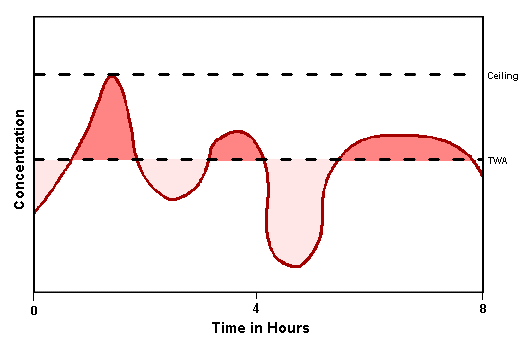Threshold Limit Values (TLVs)
TLVs are workplace exposure standards recommended by a committee of the American Conference of Governmental Industrial Hygienists (ACGIH).
What are TLVs?
TLVs are the maximum average airborne concentration of a hazardous material to which healthy adult workers can be exposed during an 8-hour workday and 40-hour workweek—over a working lifetime—without experiencing significant adverse health effects. A TLV has three components:
- Time-weighted Average (TWA) concentration: The concentration of a contaminant averaged over a workday (usually 8 hours long). It's measured in a workplace by sampling a worker's breathing zone for the whole workday. ACGIH recommends that the TWA should not be exceeded for up to an 8-hour workday during a 40-hour workweek.
- Ceiling value: A concentration of a toxic substance in air that ACGIH recommends should not be exceeded at any time during the workday. This value is often used in conjunction with the TWA.
- Short-term Exposure Limit (STEL) value: A TWA concentration over 15 minutes that ACGIH recommends not to exceed—even if the 8-hour TWA is within the standards. TWA-STELs are given for contaminants for which short-term hazards are known.
Below is a graph of concentration over an 8-hour day at a hypothetical workplace. During this day, the TWA and the ceiling value were not exceeded:
- Excursions of concentration above the TWA line were balanced out by periods when concentrations were below the line.
- While the ceiling value was reached, it was never exceeded.

How are TLVs chosen?
The ACGIH committee, with the aid of consultants, meets regularly to update existing TLVs and set new ones. The guidelines are based on available animal and human exposure studies. To find out more about the TLV development process, go to the TLV Program website.
What substances have TLVs?
TLVs have been recommended for more than 700 hazardous substances. TLVs are published annually in a booklet containing exposure guidelines for many commonly used substances.
How should TLVs be used?
It is important to remember that TLVs are recommended values, not legal limits. They do not guarantee protection to all workers and are not intended to be used for public exposure. They are not the fine line between safe and unsafe; rather, TLVs are values that should not be exceeded for long-term exposures (that is, over the course of a working lifetime). The goal is to minimize workers' exposure to hazardous concentrations as much as possible.
How does ALOHA use TLVs?
ALOHA does not include TLV values, because they are not emergency response guidelines. Furthermore, TLVs are designed for long-term exposures (over a working lifetime), but ALOHA models short-term releases for one hour from your start time. However, if TLVs are appropriate for your scenario, you could enter TLVs into ALOHA as toxic Levels of Concern (LOCs). (A toxic LOC is the value above which the toxic gas concentration might be high enough to harm people; ALOHA allows you to specify up to three toxic LOCs.) For more information on setting your own LOCs, read the Ask Dr. ALOHA article on choosing toxic LOCs.
 An official website of the United States government.
An official website of the United States government. 